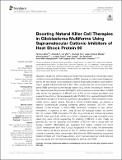| dc.contributor.author | Saha, Tanmoy | |
| dc.contributor.author | van Vliet, Amanda A. | |
| dc.contributor.author | Cui, Chunxiao | |
| dc.contributor.author | Macias, Jorge Jimenez | |
| dc.contributor.author | Kulkarni, Arpita | |
| dc.contributor.author | Pham, Luu Nhat | |
| dc.contributor.author | Lawler, Sean | |
| dc.contributor.author | Spanholtz, Jan | |
| dc.contributor.author | Georgoudaki, Anna-Maria | |
| dc.contributor.author | Duru, Adil Doganay | |
| dc.contributor.author | Goldman, Aaron | |
| dc.date.accessioned | 2021-12-16T14:47:45Z | |
| dc.date.available | 2021-12-16T14:47:45Z | |
| dc.date.issued | 2021-12-01 | |
| dc.identifier.issn | 2296-889X | |
| dc.identifier.uri | https://hdl.handle.net/1721.1/138500 | |
| dc.description.abstract | <jats:p>Allogeneic natural killer (aNK) cell adoptive therapy has the potential to dramatically impact clinical outcomes of glioblastoma multiforme (GBM). However, in order to exert therapeutic activity, NK cells require tumor expression of ligands for activating receptors, such as MHC Class I peptide A/B (MICA/B) and ULBPs. Here, we describe the use of a blood–brain barrier (BBB) permissive supramolecular cationic drug vehicle comprising an inhibitor of the chaperone heat shock protein 90 (Hsp90), which sustains a cytotoxic effect on GBM cells, boosts the expression of MICA/B and ULBPs on the residual population, and augments the activity of clinical-grade aNK cells (GTA002). First, we identify Hsp90 mRNA transcription and gain of function as significantly upregulated in GBM compared to other central nervous system tumors. Through a rational chemical design, we optimize a radicicol supramolecular prodrug containing cationic excipients, SCI-101, which displays &gt;2-fold increase in relative BBB penetration compared to less cationic formulations in organoids, <jats:italic>in vitro</jats:italic>. Using 2D and 3D biological models, we confirm SCI-101 sustains GBM cytotoxicity 72 h after drug removal and induces cell surface MICA/B protein and ULBP mRNA up to 200% in residual tumor cells compared to the naked drug alone without augmenting the shedding of MICA/B, <jats:italic>in vitro</jats:italic>. Finally, we generate and test the sequential administration of SCI-101 with a clinical aNK cell therapy, GTA002, differentiated and expanded from healthy umbilical cord blood CD34<jats:sup>+</jats:sup> hematopoietic stem cells. Using a longitudinal <jats:italic>in vitro</jats:italic> model, we demonstrate &gt;350% relative cell killing is achieved in SCI-101–treated cell lines compared to vehicle controls. In summary, these data provide a first-of-its-kind BBB-penetrating, long-acting inhibitor of Hsp90 with monotherapy efficacy, which improves response to aNK cells and thus may rapidly alter the treatment paradigm for patients with GBM.</jats:p> | en_US |
| dc.publisher | Frontiers Media SA | en_US |
| dc.relation.isversionof | 10.3389/fmolb.2021.754443 | en_US |
| dc.rights | Creative Commons Attribution 4.0 International license | en_US |
| dc.rights.uri | https://creativecommons.org/licenses/by/4.0/ | en_US |
| dc.source | Frontiers | en_US |
| dc.title | Boosting Natural Killer Cell Therapies in Glioblastoma Multiforme Using Supramolecular Cationic Inhibitors of Heat Shock Protein 90 | en_US |
| dc.type | Article | en_US |
| dc.identifier.citation | Saha, Tanmoy, van Vliet, Amanda A., Cui, Chunxiao, Macias, Jorge Jimenez, Kulkarni, Arpita et al. 2021. "Boosting Natural Killer Cell Therapies in Glioblastoma Multiforme Using Supramolecular Cationic Inhibitors of Heat Shock Protein 90." 8. | |
| dc.contributor.department | Massachusetts Institute of Technology. Department of Chemistry | |
| dc.eprint.version | Final published version | en_US |
| dc.type.uri | http://purl.org/eprint/type/JournalArticle | en_US |
| eprint.status | http://purl.org/eprint/status/PeerReviewed | en_US |
| dspace.date.submission | 2021-12-16T14:32:42Z | |
| mit.journal.volume | 8 | en_US |
| mit.license | PUBLISHER_CC | |
| mit.metadata.status | Authority Work and Publication Information Needed | en_US |
